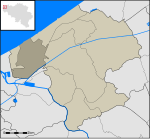Middelkerke

Middelkerke (Dutch pronunciation: [ˈmɪdəlˌkɛrkə]) is a municipality located in the Belgian province of West Flanders, on the North Sea, west of Ostend. The municipality comprises the villages of Leffinge, Lombardsijde, Mannekensvere, Middelkerke proper, Schore, Sint-Pieters-Kapelle, Slijpe, Westende and Wilskerke. On January 1, 2006, Middelkerke had a total population of 17,841. The total area is 75.65 km2 which gives a population density of 236 inhabitants per km2. The first reference of 'Middelkerca' is found in 1218. Before 1876 it mainly was a farming settlement. In 1902, Middelkerke became the world's first municipality to have their drinking water disinfected by continuous chlorination.
Excerpt from the Wikipedia article Middelkerke (License: CC BY-SA 3.0, Authors, Images).Middelkerke
Ten Poele II,
Geographical coordinates (GPS) Address Nearby Places Show on map
Geographical coordinates (GPS)
| Latitude | Longitude |
|---|---|
| N 51.183333333333 ° | E 2.8166666666667 ° |
Address
Ten Poele II
Ten Poele II
8430 (Middelkerke)
West Flanders, Belgium
Open on Google Maps









